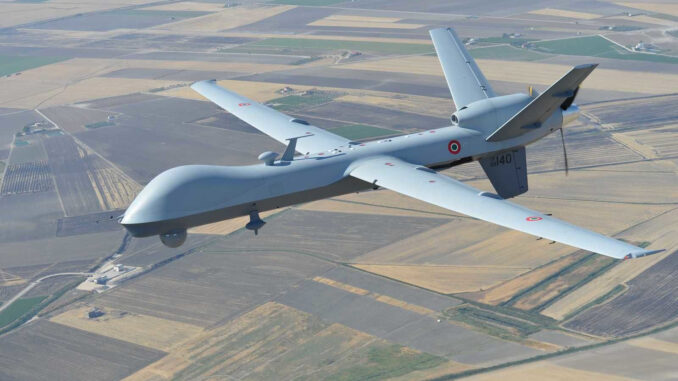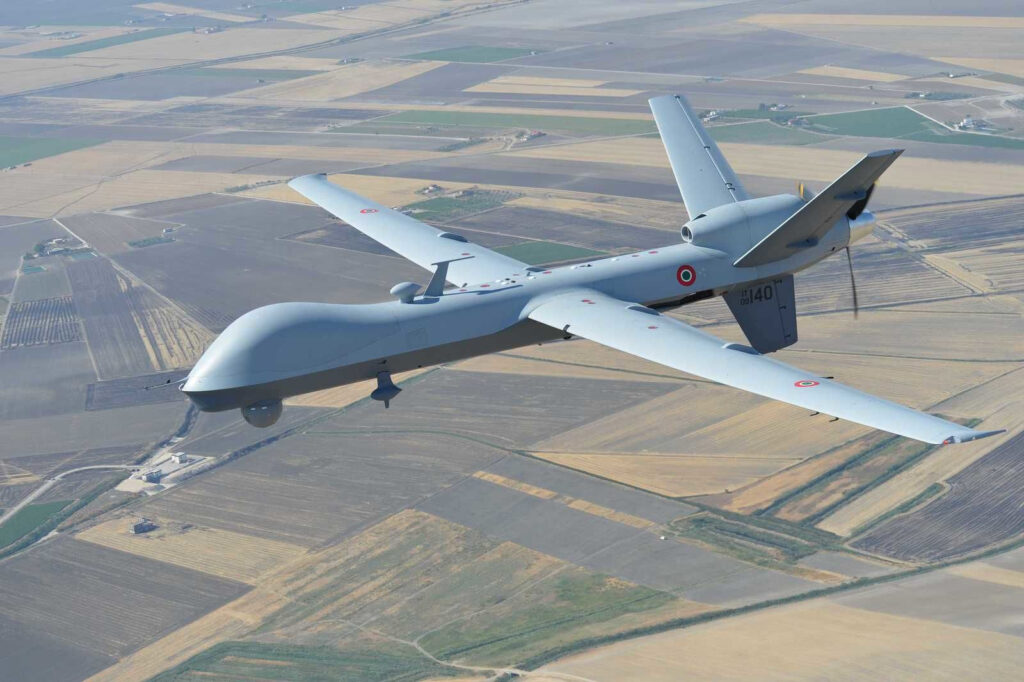
Analysis of the role of MQ-9 Reaper UAVs in simulated operations in the South China Sea, with military technical and tactical data.
The MQ-9 Reaper military UAV was used in a simulated conflict scenario in the South China Sea during the ‘Reaper Smoke’ competition. The exercise highlights the growing importance of UAVs in contested environments, with simulations carried out around disputed reefs such as Mischief Reef. As geopolitical tensions rise in this region, the use of drones, such as the MQ-9, is helping to perfect large-scale surveillance and intelligence strategies. The US Air Force is focusing on adapting these drones for more varied missions in hostile environments, underlining their key role in future conflicts.
The MQ-9 Reaper and its simulated role
The MQ-9 Reaper is one of the most widely used UAVs in the US Air Force, designed primarily for Intelligence, Surveillance and Reconnaissance (ISR) missions, as well as having the capability to carry out targeted strikes. During the Reaper Smoke 2024 competition, these drones were tested in a simulated combat scenario over the Mischief Reef, a disputed territory in the South China Sea. This reef, located approximately 240km west of the Philippine island of Palawan, is of strategic importance due to the geopolitical tensions surrounding it, being claimed by China, Taiwan and Vietnam, although it lies within the exclusive economic zone (EEZ) of the Philippines.
Since the 1990s, China has taken control of this reef and built a large artificial island, including a port and a 2,643-metre landing strip. This infrastructure enables China to assert its claim to the area, while at the same time strengthening its military presence in the region. The use of the Mischief Reef in the Reaper Smoke scenarios highlights the complexity of potential conflicts around the South China Sea and the role of drones as instruments of power.

The strategic role of the Reaper in contested environments
The deployment of the MQ-9 Reaper in a simulated conflict in the South China Sea raises questions about the relevance of these drones in contested environments. Exercises such as Reaper Smoke are designed to test the capabilities of UAV pilots and sensor operators in complex tactical situations. Air forces face challenges ranging from general tactical manoeuvres to specialised skills requiring advanced techniques.
These UAVs, although initially developed for ISR and strike missions in permissive environments, are now being adapted for high-intensity conflict in the face of adversaries capable of disrupting their operations. Recent US Air Force operations have shown that MQ-9 Reaper drones have been shot down in less contested areas such as Yemen, with an estimated loss of eight drones by Houthi forces since the start of the war.
Adapting the MQ-9 for more complex missions has thus become a priority. For example, the Adaptive Airborne Enterprise (A2E) concept aims to make these UAVs more versatile and capable of taking part in missions that go beyond simple surveillance tasks. This concept includes the possibility for a crew to control several drones at the same time, a major advance for operations in highly contested airspace, such as the South China Sea.
The phases of the A2E project and the adaptation of the MQ-9 Reaper
The A2E initiative was launched to extend the capabilities of the MQ-9 Reaper UAVs into more complex and hostile environments. This project is divided into five main phases, the first three of which are currently under development:
- Phase 1: Replacement of the traditional stationary UAV control system with an A2E interface, optimised for operations in austere areas.
- Phase 2: Development of the capability for a crew to fly several MQ-9 simultaneously.
- Phase 3: Integration of the capability for a crew to fly different types of UAVs, ranging from the smallest RQ-11B Raven models to larger UAVs such as the MQ-9 Reaper.
- Phase 4: Ability to control drone formations from mobile and austere sites.
- Phase 5: Creation of effects-based ISR units, including field teams, cyber operators and space operators, capable of collaborating to employ UAVs in permissive, contested or prohibited environments.
These phases are designed to maximise the effectiveness of the MQ-9 Reaper in future conflicts, where the combat environment will be more dynamic and uncertain.
Strategic consequences of the Reaper in the South China Sea
The deployment of MQ-9 UAVs in the Indo-Pacific region, particularly in the South China Sea, underlines the rising geopolitical tensions in this area. China’s military presence in the Spratlys Islands and its territorial claims make this a potentially explosive area for future confrontations between major powers. The ability of the MQ-9s to carry out long-range surveillance missions, while avoiding enemy defence systems, reinforces their importance in US military strategies.
Continuous improvement in the capabilities of these UAVs is crucial to maintaining a balance of forces in this region. Ultimately, the ability of the MQ-9 to act as a “mothership ’ for other smaller UAVs and to operate in a network with other military assets could play a decisive role in a potential conflict with China.
Exercises such as Reaper Smoke help to refine tactics and train crews capable of operating in increasingly contested environments, ensuring that MQ-9 UAVs remain a viable and adaptable operational force.
War Wings Daily is an independant magazine.